Last Updated on: 31st March 2025, 04:06 pm
Cricket Fielding Drills
Improve Your Reactions, Agility & Catching Skills
Fielding drills will be an important part of your cricket training. After all, strong fielding skills can make a big difference to your team’s performance. A great fielder can save runs, create wicket-taking opportunities, and put pressure on the batting side. Whether you’re diving to stop a boundary, sprinting to cut off a single, or taking a sharp catch in the slips, you can change the course of a game. That’s why cricketers need to focus on their skills and take part in fielding drills.
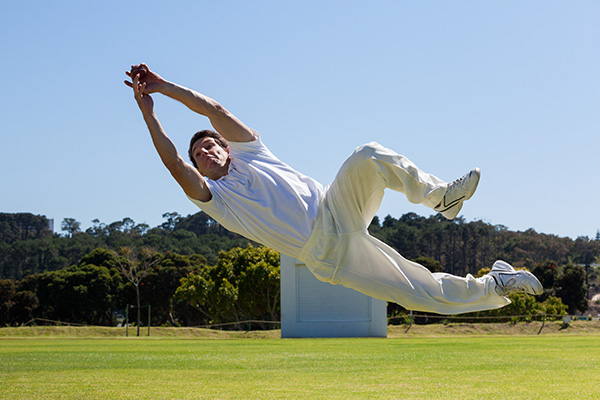
What Makes a Great Fielder?
Having strong fielding skills will definitely contribute to your team’s success because it means you can save runs and dismiss batsmen. So, getting your fielders up to their full potential will really put the pressure on your opponents.
Firstly, you need to be physically fit. Speed and endurance training, as well as flexibility and strength exercises, will keep you in top form. A good fielder needs a combination of speed, agility, anticipation, and strong hands. Secondly, you’ll want to work on specific cricket skills.
Basically, to be a good fielder, you’ll want to work on the following:
Speed & Agility
Fielders must be quick on their feet to cut off boundaries, chase down balls, and move into the right position for catches. Sprint training and agility drills are essential. You also want good lateral movement, so you’re ready to move in any direction.
Sharp Reflexes & Reactions
Whether in the slips, at point, or close to the bat, fielders have to be ready for anything. Reflexes and reaction times are going to be key areas to focus on. So, spend time on drills to improve your reflexes and hand-eye coordination.
Great Catching Techniques
Dropping a catch can be the difference between winning and losing. Therefore, you’ll need to be confident in your ability. Practice different techniques to catch different types of balls. Then work on being able to judge a ball and understand which technique to use.
Anticipation & Game Awareness
Top fielders don’t just react—they read the game. They’ll always be watching the batsman’s movement and predicting where the ball will go. Then they can position themselves better. Good fielders need to be flexible and ready for anything.
Communication & Teamwork
Calling for catches, coordinating with teammates, and backing up throws are vital skills. A fielder should always be loud, clear, and confident on the field.
Basic Stance
Before getting into anything else, you need to make sure you have the correct stance. Think about the following:
- Keep your feet shoulder-width apart.
- Bend your knees slightly for balance and flexibility.
- Keep your back straight and lean forward slightly so you can react quickly.
- Position your hands in front of you so you’re ready to react to the ball.
- Stay focused on the batsman so you can anticipate the ball’s movement.
- Keep on the balls of your feet so you’re ready to follow the ball in any direction.
If you ensure you’re maintaining a proper fielding stance, you’ll be in a strong position on the field. Following these tips will ensure you’re balanced, stable and allow you to react to anything. You’ll become a more effective fielder and your team will be in a stronger position.
Essential Cricket Fielding Drills
To stay at the top of your game, you need to continue developing your skills, so we’ve included some example fielding drills to improve your performance.
Reaction Catching Drill

Equipment Needed: 1 cricket ball
Set-Up:
- Divide players into pairs.
- The players stand 5-6 metres apart.
- Give one player a ball. They will be the thrower.
Instructions:
- The thrower calls “Ready?” and then throws the ball at a random time.
- The fielder must react as quickly as possible and take the catch.
- Begin with underarm throws to build confidence, then progress to overarm throws for added difficulty.
- Perform three sets of ten catches before switching roles.
Make It Harder:
- Decrease the reaction time by having the thrower release the ball immediately after calling “Ready?”
- Have the thrower release the ball without shouting first.
- Use a smaller ball to make catching more challenging.
- Have the fielder stand on one leg to improve balance and focus.
- Introduce different types of throws (e.g., spinning or bouncing the ball before it reaches the fielder).
- Perform the drill under low-light conditions or with sunglasses to simulate difficult match scenarios.
Why This Drill Helps:
- Improves reflexes and hand-eye coordination.
- Helps players develop soft hands for better catching control.
- Trains fielders to stay alert and react instantly in real match situations.
Boundary Sprint & Throw Drill
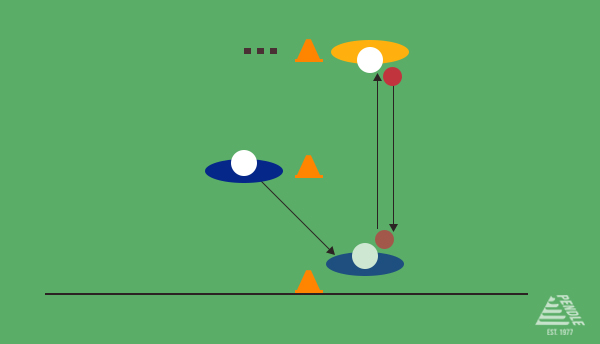
Equipment Needed: 1 cricket ball, 3 cones
Set-Up:
- Divide players into pairs.
- Place one cone at the boundary, another 10 metres inside, and the last one near the stumps.
- The fielder starts at the middle cone.
- A partner stands near the stumps to receive the throw.
Instructions:
- The coach hits or rolls the ball towards the boundary.
- The fielder sprints to collect the ball as quickly as possible.
- After gathering the ball, they turn and throw it to the wicketkeeper at the stumps.
- The fielder jogs back to the middle cone and resets for the next turn.
- Repeat 10 times, then rotate players.
Make It Harder:
- Increase the Distance: Move the boundary cone further away to force longer sprints and throws.
- Add a Relay Partner: Have a second fielder in the middle to relay the ball with a quick return throw before it reaches the wicket.
- Time Pressure: Set a 5-second limit from pick-up to throw to encourage faster reactions.
- Diving Pick-Up: The coach can hit the ball at different angles to force the fielder to dive and recover quickly.
- Weaker-Hand Throws: Force players to use their non-dominant hand for certain rounds to improve versatility.
Why This Drill Helps:
-
- Improves speed, stamina, and throwing accuracy.
- Simulates real match situations where boundary fielding is crucial.
- Develops decision-making under pressure and strengthens the throwing arm.
Rapid Reaction Slip Catching
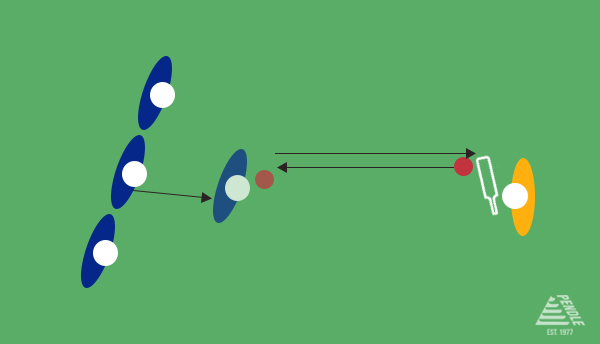
Equipment Needed: 1 cricket bat, 1 ball, a batter
Set-Up:
- Divide players into groups of 3 (or more if necessary).
- Players stand in a slip cordon formation.
- The batter stands in front with a bat and ball.
Instructions:
- The batter gently edges the ball towards the slips using the bat.
- Fielders react quickly and attempt to take the catch.
- After catching, the fielder tosses the ball back to the coach and gets ready for the next one.
- Rotate positions after 10 catches to give everyone experience at different angles.
Make It Harder:
- Increase the speed of edges to reduce reaction time.
- Use a harder ball (cricket ball or rubber ball) for realistic impact.
- Add multiple batters to create random deflections.
Why This Drill Helps:
- Improves reflexes and hand-eye coordination.
- Enhances the ability to take sharp, low catches under pressure.
- Trains slip fielders and wicketkeepers to react instinctively.
Direct-Hit Target Throwing
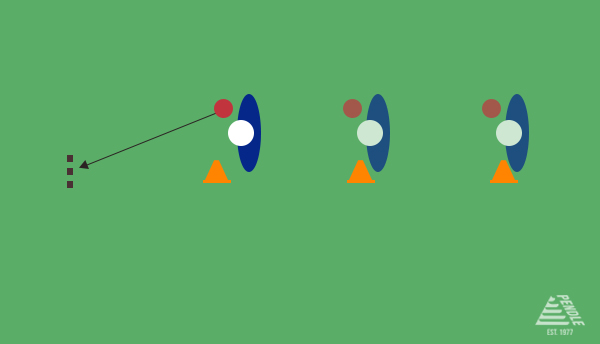
Equipment Needed: 1 cricket ball, a set of stumps, cones
Set-Up:
- Place a set of stumps at one end of the field.
- Mark different throwing distances using cones (10m, 15m, 20m).
Instructions:
- Players take turns throwing at the stumps from different distances.
- Start with stationary throws, focusing on accuracy.
- Progress to on-the-run throws, simulating a real match.
- Keep track of successful direct hits, turning it into a friendly competition.
Make It Harder:
- Increase the throwing distance.
- Introduce time pressure (players must release the ball within 2 seconds).
- Make fielders dive or pick up a rolling ball before throwing.
Why This Drill Helps:
- Improves throwing accuracy and speed.
- Develops the ability to hit the stumps consistently in run-out situations.
- Teaches quick ball pick-up and release under pressure.
Long Barrier Fielding Drill
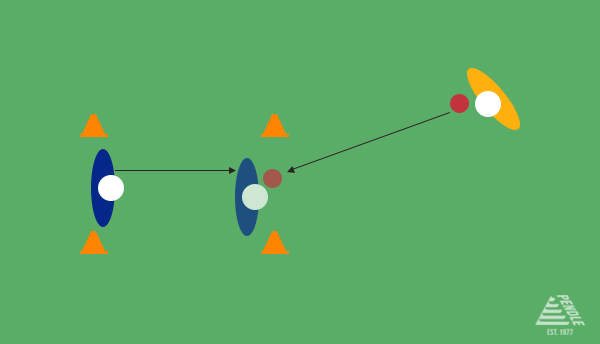
Equipment Needed: 1 cricket ball, 4 cones
Set-Up:
- Divide teams into pairs.
- Place two cones 5 metres apart to mark a starting position for the fielder.
- Set up another two cones 10-15 metres away to indicate the ball delivery area.
- The coach or partner stands behind the cones with a ball, ready to roll it towards the fielder.
Instructions:
- The fielder starts in a low, ready position at the starting cones.
- The feeder rolls the ball towards them, simulating a shot along the ground.
- The fielder sprints towards the ball and uses the long barrier technique to stop it.
- They then quickly pick up the ball and throw it back to the coach.
- Repeat 10 times, focusing on correct form and smooth transitions.
Key Coaching Points:
- Keep the knee and foot close together to ensure the ball doesn’t slip through.
- Use soft hands to absorb the impact of the ball.
- Get low and balanced to maintain control when stopping the ball.
- Transition quickly from the barrier to the throw to simulate match conditions.
Ways to Make It Harder:
- Increase the rolling speed to challenge reaction time.
- Introduce random ball placement so the fielder has to adjust quickly.
- Add a second ball to force quick recovery and movement.
- Time the fielder and set a target reaction time for each stop and throw.
Why This Drill Helps:
- Reinforces proper long barrier technique for effective ground fielding.
- Helps players develop quick reflexes and body positioning.
- Improves transition from fielding to throwing in game situations.
Train Hard, Field Smarter!
Strong fielders can sometimes be the difference between a win and a loss in cricket. Whether it’s by saving runs or taking game-changing catches, fielders can change the outcome. Therefore, consistently including fielding drills in your training will elevate your game. Looking for high-performance cricket training gear? Check out our latest range of training wear and accessories for shorts, training tops, bucket hats, cricket caps and more.

